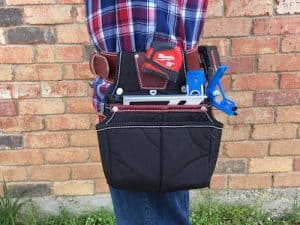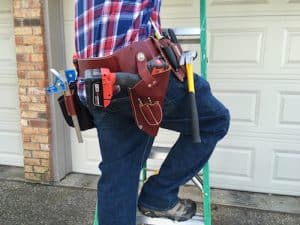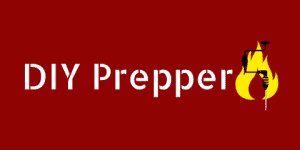A couple of years ago, my grandmother decided to sell her house. Before she could do this, we had to go through everything and decide what the family would take and what we would sell. As I was going through the basement looking for tools I could scavenge, I found my grandfather’s old tool belt. I asked myself, “Do I even need a tool belt?”. Being inexperienced and ignorant, I thought I didn’t need one since I had a small workbench in my garage. However, after doing some projects, I knew that I made a mistake by leaving that old tool belt behind. Many of them would have been much easier if I had a good tool belt setup.
I learned that a DIY’er can’t live by a workbench alone. Even while doing projects in my garage, I was constantly looking for tools I had set down somewhere or tripping over others that I had laid on the floor to “get them out of the way”. Without a tool belt to keep things organized, everything was in the way. If it wasn’t in the way, it was missing when I needed it. This was one of the most frustrating things about doing projects. I decided that I needed a tool belt to help me work more efficiently.
Tool Belt Types and Brands
There are many different types of tool belts. They range from cloth aprons that cost a few dollars all the way to complete framing belt setups that can cost hundreds. Cloth aprons are fine if you are doing light work or have a large, well-organized shop. However, if you need to move around a lot or have limited space to set down tools, a larger tool belt setup will suit your needs better. It will also help save your back by reducing how often you have to bend over to pick up a tool.
Related: How to Get Good Tools Cheap
Tool belts often come with bags and pouches to serve specific tasks. Most of the tool belts that hardware stores sell are “carpenter’s belts”. These hold the tools most commonly used in general construction and are usually good choices for a DIY’er. Others, such as electrician’s belts, have special pouches to hold trade-specific tools.
Several companies produce tool belts, and some of the best are made by Occidental Leather, Custom Leathercraft, and Bucket Boss. Belts from companies such as these have high-quality materials and are more user-friendly.
For my tool belt setup, I chose to build my own with components made by Occidental Leather. Building my own allowed me to choose my bags and pouches based on my needs at the time. If my needs change, I can purchase new components and swap them with the old ones. I used components from Occidental Leather due to their outstanding reputation. I wanted a tool belt that would last me decades, and according to several reviews, their products are more than capable of doing so.
The Belt

The heart of any tool belt setup is the actual belt. A good tool belt looks a lot like a weight lifter’s belt. It is thick and wide to help distribute the weight of the tools. I would recommend getting one made of leather as it seems to hold up better over time. As long as it is the correct thickness, it will hold its shape when weighted down better than nylon. It is amazing how even with new “space-age” materials, leather is still one of the best materials for long life and durability.
For my tool belt setup, I chose to get an Occidental Leather Ranger Belt. It is a well-designed and high-quality belt. The thick and wide leather is more than sufficient to support the weight of my tools without the belt digging into my waist. To aid with movement, the belt becomes narrow towards the front. This allows the user to bend over without the belt jabbing them in the stomach. The buckle is heavy-duty steel with a roller to make tightening easier. You find it by clicking here.
The only problem I have with this belt is that sizing seems to run a little small. My first belt was a medium. I thought this would be large enough since I wear size 34 waist jeans. After I added bags to the belt, it was barely large enough. I traded it in for large, which is just the right size. If you order an Occidental Leather belt, be sure to keep this in mind.
Fastener Bag

Nearly any project that you do will require fasteners, such as nails or screws. These can be very easy to misplace or spill if you are just setting them down somewhere. Fastener Bags hold screws and nails so that they are nearby and out of the way until you need them. A good fastener bag will have one or more deep pouches designed to hold your fasteners without spilling them, even while you are moving around.
Fastener bags also hold tools that are usually grasped by the non-dominant hand. They include speed squares, combination squares, and nail sets. Because of this, manufacturers offer fastener bags in both left and right-handed varieties. Make sure that you get the correct one. This will allow you to have greater efficiency and less frustration as you work.
For my tool belt setup, I chose the Occidental Leather OxyFinisher Fastener Bag. It comes with two outer pouches, which allows you to hold two different types of nails or screws and keep them separate. There is also a large main compartment in the middle of the bag, a speed square slot, and a small pocket for thin items. The bag also has leather tool holders for a tape measure, combination square, and two slots for nail sets or drill bits. It also comes with a plastic tool shield to protect your bag if you need to carry a knife or chisel. The pouch is constructed of heavy-duty nylon, with good stitching, and rivets at stress points. Although it isn’t made of leather, I feel confident that it will last for years.
Tool Bag or Tool Pouch

The next component of a tool belt system is the tool bag or tool pouch. A full-size tool bag is good for heavy construction, such as framing. Larger tool bags can hold numerous tools, such as screwdrivers, tape measures, pencils, utility knives, chisels, chalk lines, and even hammers. Due to the amount of weight that they will hold, bags such as these are made of thick and heavy materials, such as full-grain leather or heavy-duty nylon. Like fastener bags, tool bags are offered in both left-hand and right-hand versions.
Most of my projects are small by comparison, so I decided to just get an Occidental 5 in 1 tool pouch for my belt setup. It will hold pliers, a utility knife, chisel, and a pencil. Like the OxyFinisher Fastener Bag, it has a plastic tool shield to protect the pouch from damage caused by sharp chisels or knives. If you take the tool shield out, the slot it fits into is large enough to hold a pair of linesman pliers.
The 5 in 1 pouch also has a metal hammer loop on the front. I use a drill more often than I do a hammer, so I don’t use the hammer loop too often. However, it is great when I do, because it keeps the hammer far out from my body so the handle doesn’t knock against my legs as I am moving.
*Update*
After using my tool belt for a while, I came to realize that certain projects definitely require the use of a full-size tool bag. While the 5 in 1 tool pouch is great when I am working in my shop or doing small jobs, there were times when I needed something larger to hold the tools I needed.
To solve this problem, I got an Occidental Leather OxyLights Three Pouch Tool Bag. Like my fastener bag, it is made of heavy-duty nylon and includes seven leather compartments to hold various tools. It gives me plenty of room to hold screwdrivers, pliers, a tape measure, pencils, a chalk line, and much more.
Drill Holster

Most of the projects that I do use a lot of deck screws and pocket hole screws. For this reason, I use a cordless drill or impact driver quite a bit. They are must-have tools for various projects, but they take up a lot of bench space. They are also hazardous if just laid down on the floor. I have lost count of the times I have nearly face-planted after setting my drill or impact driver down.
Because of this, I decided that my tool belt setup needed to have a drill holster. Having one would allow me to have my drill nearby but out of the way. It also makes working on a ladder much safer. With my drill in the holster, I have both hands free to climb the ladder, instead of juggling a drill as a climb. Another added benefit of the holster is that it also prevents me from having to store my drill or impact in my fastener bag, freeing up space inside.
You can find Occidental Leather’s Drill Holster by Clicking Here.
Like the other components of my tool belt setup, my drill holster is from Occidental Leather. It features strong, but flexible leather for the main body of the holster and more rigid leather where it attaches to the belt. It includes two slots on the outside for drill bits and a retention strap to prevent the drill from falling out when not in use. The bottom of the holster is left open to allow the user to keep a drill bit in the chuck while in the holster.
